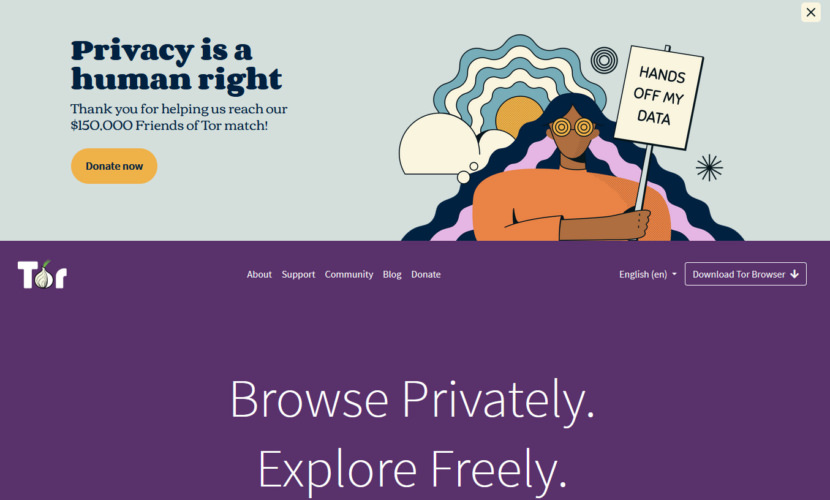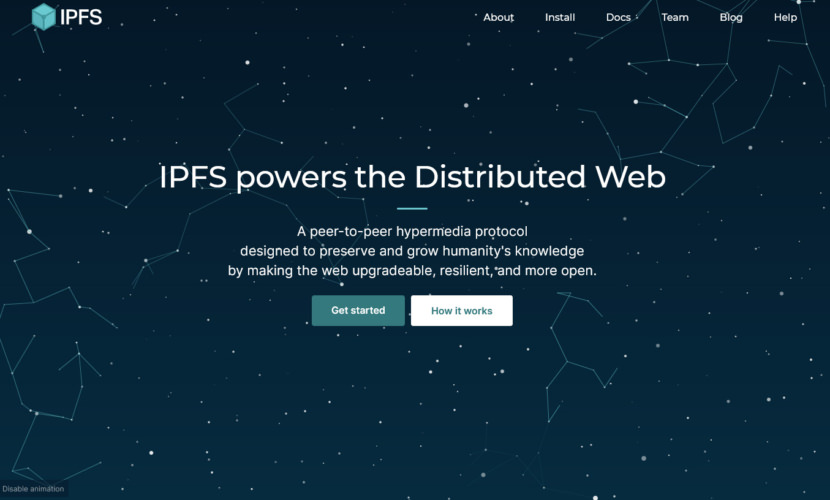The conventional Internet is currently like a system of roads with deep potholes and highwaymen all over the place. Even if you still can use the roads (e.g. send emails, or browse websites) your vehicle might get hijacked, damaged, or long arms might reach into its back and steal your items (data) to use it against you and sell it to others – while you can’t even notice the thievery nor accuse and hold the scroungers accountable.
Continue ➤ 4 Free P2P Intranet Software – Create Home Office File Sharing Network
The Internet was not designed with security in mind: protecting against address forgery, routers learning metadata, or choosing trustworthy third parties is nontrivial and sometimes impossible. These self-contained anonymizing networks provide improving addressing, routing, naming and content distribution in a technically robust manner – as opposed to ad-hoc designs in place today.
1. Tor Project
Tor, short for The Onion Router, is for enabling anonymous communication. It directs Internet traffic through a free, worldwide, volunteer overlay network, consisting of more than six thousand relays, for concealing a user’s location and usage from anyone conducting network surveillance or traffic analysis.
- Block Trackers – Tor Browser isolates each website you visit so third-party trackers and ads can’t follow you. Any cookies automatically clear when you’re done browsing. So will your browsing history.
- Defend Against Surveillance – Tor Browser prevents someone watching your connection from knowing what websites you visit. All anyone monitoring your browsing habits can see is that you’re using Tor.
- Resist Fingerprinting – Tor Browser aims to make all users look the same, making it difficult for you to be fingerprinted based on your browser and device information.
- Multi-Layered Encryption – Your traffic is relayed and encrypted three times as it passes over the Tor network. The network is comprised of thousands of volunteer-run servers known as Tor relays.
2. I2P
The Invisible Internet Project (I2P) is an anonymous network layer that allows for censorship-resistant, peer-to-peer communication. Anonymous connections are achieved by end-to-end encrypting the user’s traffic, and sending it through a volunteer-run network of roughly 55,000 computers distributed around the world.
I2P has created transport protocols that resist DPI censorship, and continuously improves its end to end encryption. I2P hides the server from the user and the user from the server. All I2P traffic is internal to the I2P network. Traffic inside I2P does not interact with the Internet directly. It is a layer on top of the Internet.
3. Hyphanet
Hyphanet is a peer-to-peer platform for censorship-resistant, anonymous communication. It uses a decentralized distributed data store to keep and deliver information, and has a suite of free software for publishing and communicating on the Web without fear of censorship.
Hyphanet is free software which lets you anonymously share files, browse and publish “freesites” (web sites accessible only through Hyphanet) and chat on forums, without fear of censorship. Hyphanet is decentralised to make it less vulnerable to attack, and if used in “darknet” mode, where users only connect to their friends, is very difficult to detect.
4. ZeroNet
ZeroNet is a decentralized web-like network of peer-to-peer users. Instead of having an IP address, sites are identified by a public key (specifically a bitcoin address). The private key allows the owner of a site to sign and publish changes, which propagate through the network. Sites can be accessed through an ordinary web browser when using the ZeroNet application, which acts as a local webhost for such pages.
- Open, free and uncensorable websites, using Bitcoin cryptography and BitTorrent network
- Peer-to-Peer – Your content distributed directly to other visitors without any central server.
- Anonymity – You can easily hide your IP address using the Tor network.
- No passwords – Your account is protected by the same cryptography as your Bitcoin wallet.
5. Retroshare
Peer-to-peer communication and file sharing app based on a friend-to-friend network built on GNU Privacy Guard (GPG). Optionally, peers may communicate certificates and IP addresses to and from their friends.
Retroshare establishes encrypted connections between you and your friends to create a network of computers, and provides various distributed services on top of it: forums, channels, chat, mail and more. Retroshare is fully decentralized, and designed to provide maximum security and anonymity to its users beyond direct friends.
- Chat – Send text and images. Discuss with various people in decentralized chat rooms (like IRC). Express your emotions with the rich smiley set. Use distant chat to securely chat with friends-of-friends.
- Mail – Send encrypted messages to other members of the network. Retroshare securely stores messages on friends’ nodes to deliver messages while you’re offline.
- File sharing – Share files with your friends or with the whole network. Use the search to find files. Retroshare uses swarming similar to BitTorrent, to accelerate transfers. This makes it possible to share large files. Your privacy and anonymity is guaranteed beyond direct friends with anonymous tunnels.
- Forums – You can read and write forum posts offline. This is perfect while you’re on the go. When you have an Internet connection, Retroshare will automatically sync forums with your friends. Decentralized forums are censorship resistant by design.
- Boards – Share your favorite pictures or links. See which pictures or links others like. Vote and discuss them using the built-in commenting system.
- Channels – Channels allow you to publish your files. You may subscribe to channels and automatically download the latest files; comment on files and spread them to your friends.
- Voice and Video (Experimental Prototype) – Make free and secure calls with the VoIP plugin. Catch up face to face with a video call.
6. InterPlanetary File System
The InterPlanetary File System (IPFS) is a protocol and peer-to-peer network for storing and sharing data in a distributed file system. IPFS uses content-addressing to uniquely identify each file in a global namespace connecting all computing devices. A peer-to-peer hypermedia protocol designed to preserve and grow humanity’s knowledge by making the web upgradeable, resilient, and more open.
- Archivists – Storing archival data using IPFS enables deduplication, clustered persistence, and high performance — empowering you to store the world’s information for future generations.
- Service providers – Providing large amounts of data to users? Storing on IPFS could help you slash bandwidth costs thanks to its use of secure, peer-to-peer content delivery.
- Researchers – If you’re working with or distributing large datasets, storing that data using IPFS can help speed up performance and unlock decentralized archiving.
- Blockchain developers – IPFS content addressing enables you to store large files off-chain and put immutable, permanent links in transactions — timestamping and securing content without having to put the data itself on-chain.
- Content creators – IPFS empowers creators to build and share on the decentralized web — whether that’s delivering content free from intermediary control or minting NFTs that stand the test of time.
- Offline users – High-latency networks cause major obstacles for those with poor internet infrastructure. Peer-to-peer IPFS offers resilient access to data independent of latency or backbone connectivity.
7. GNUnet
GNUnet is an alternative network stack for building secure, decentralized and privacy-preserving distributed applications. Their goal is to replace the old insecure Internet protocol stack. Starting from an application for secure publication of files, it has grown to include all kinds of basic protocol components and applications towards the creation of a GNU internet.
For decentralized, peer-to-peer networking and an official GNU package. The framework offers link encryption, peer discovery, resource allocation, communication over many transports (such as TCP, UDP, HTTP, HTTPS, WLAN and Bluetooth) and various basic peer-to-peer algorithms for routing, multicast and network size estimation.












